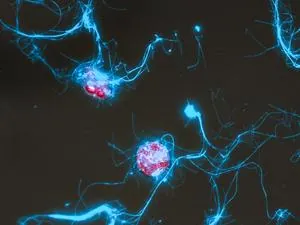
The Ocean's Secret: How Microbes Feast on Carbon with a Glowing Twist
2025-07-10
Author: Sarah
Unlocking the Mysteries of Marine Sugars
In a groundbreaking study, an innovative team of chemists, microbiologists, and ecologists has developed a molecular probe that illuminates when sugars are consumed. Published in the prestigious Journal of the American Chemical Society, this discovery sheds light on the fierce hidden battle between algae and microbial degraders in our oceans.
Jan-Hendrik Hehemann from the Max Planck Institute for Marine Microbiology emphasizes the importance of this research, stating, "Sugars are everywhere in marine ecosystems, yet it remains a mystery how microbes break them down—or even if they can." Peter Seeberger, also from the Max Planck Institute, adds, "This new probe allows real-time observation of this fascinating process."
The Carbon Connection: Algae and Sugars
Algae play a pivotal role in the marine carbon cycle by capturing carbon dioxide and converting it into oxygen and organic matter, with sugars forming a crucial part of that conversion. However, many sugars are complex and prove challenging for most microbes to digest, leading to carbon sinking to the ocean floor and remaining dormant for centuries until the right enzymes arrive.
A Breakthrough in Sugar Degradation Tracking
To tackle the challenge of identifying which microbes degrade which sugars, the research team utilized automated glycan assembly to create a sugar probe tagged with two fluorescent dyes. These dyes interact through Förster resonance energy transfer (FRET), acting as a molecular switch: the probe stays dark until an enzyme cleaves the sugar's backbone, causing it to glow. This allows researchers to precisely monitor the breakdown of sugars like α-mannan, a polysaccharide prevalent in algal blooms.
Pioneering Insights into Microbial Metabolism
This FRET glycan probe opens new avenues for studying microbial metabolism in real time, even without prior genomic knowledge. Researchers can now accurately locate active degraders, track the progression of glycan degradation, and quantify turnover rates within complex microbial communities. This powerful tool promises deeper insights into glycan cycling across diverse ecosystems—from flourishing ocean algal blooms to the complexities of the human gut.
The Bigger Picture: Understanding Ocean Carbon Flux
By observing which microbes are activated in response to various conditions, scientists can link specific enzymatic activities to broader environmental processes. Conor Crawford, the first author of the study, succinctly sums it up: "Sugars are central to the marine carbon cycle. With this FRET probe, we can ask the essential questions: Who's eating what, where, and when?" This innovative approach holds the potential to revolutionize our understanding of carbon flux in the ocean, uncovering the intricate relationships that govern marine ecosystems.


 Brasil (PT)
Brasil (PT)
 Canada (EN)
Canada (EN)
 Chile (ES)
Chile (ES)
 Česko (CS)
Česko (CS)
 대한민국 (KO)
대한민국 (KO)
 España (ES)
España (ES)
 France (FR)
France (FR)
 Hong Kong (EN)
Hong Kong (EN)
 Italia (IT)
Italia (IT)
 日本 (JA)
日本 (JA)
 Magyarország (HU)
Magyarország (HU)
 Norge (NO)
Norge (NO)
 Polska (PL)
Polska (PL)
 Schweiz (DE)
Schweiz (DE)
 Singapore (EN)
Singapore (EN)
 Sverige (SV)
Sverige (SV)
 Suomi (FI)
Suomi (FI)
 Türkiye (TR)
Türkiye (TR)
 الإمارات العربية المتحدة (AR)
الإمارات العربية المتحدة (AR)